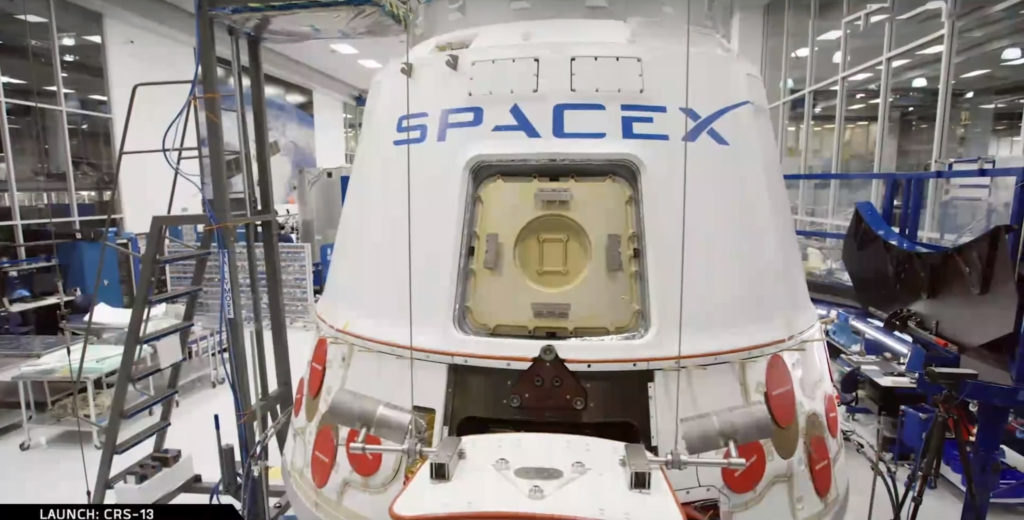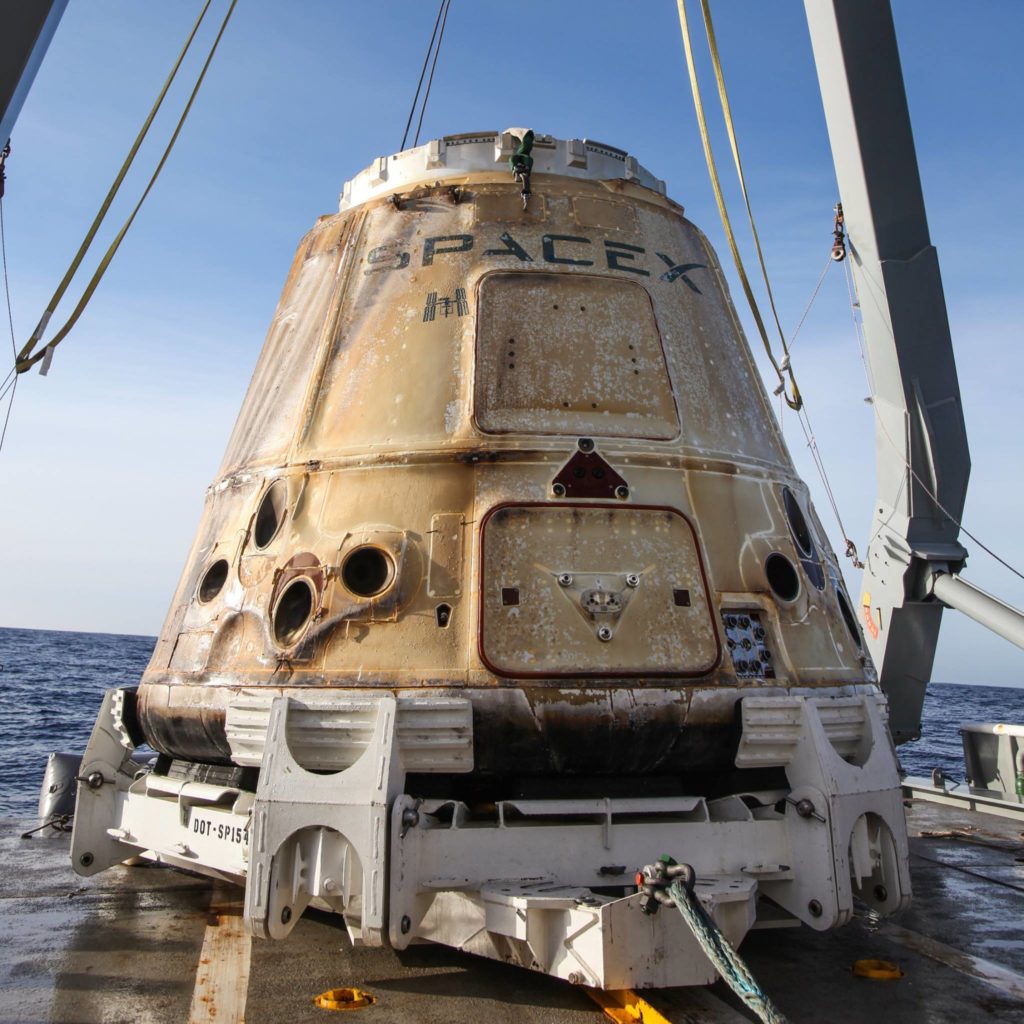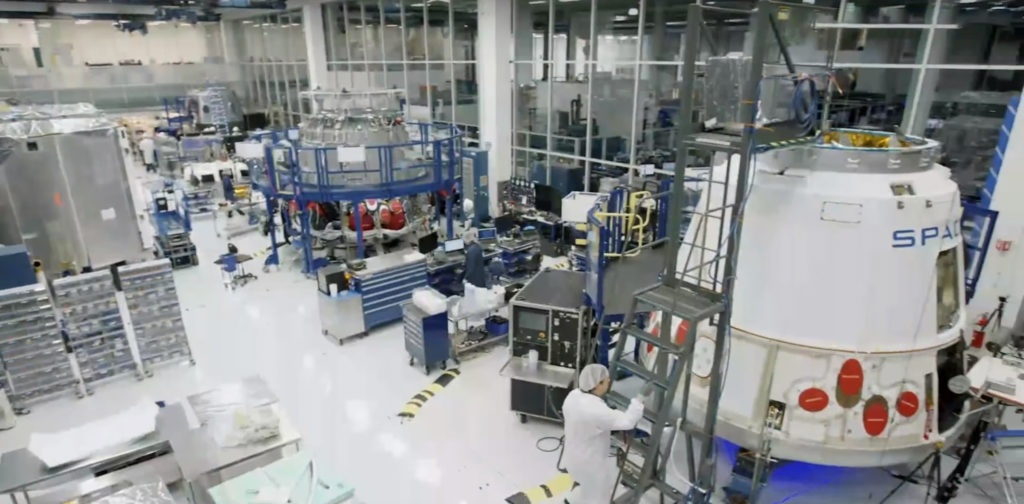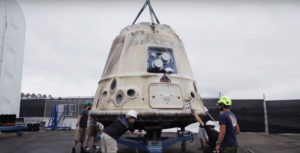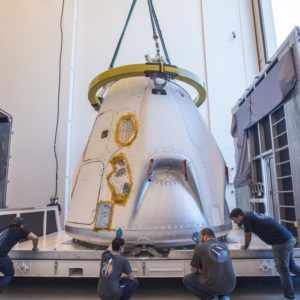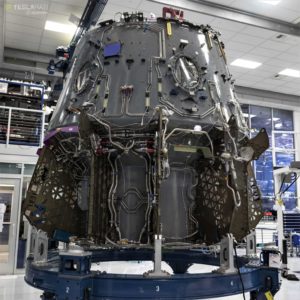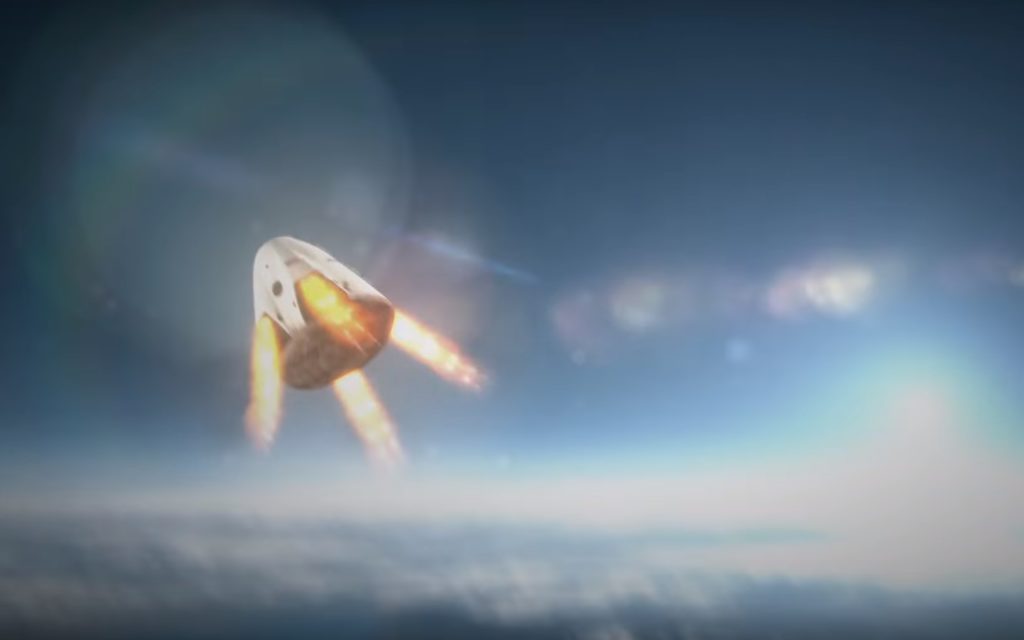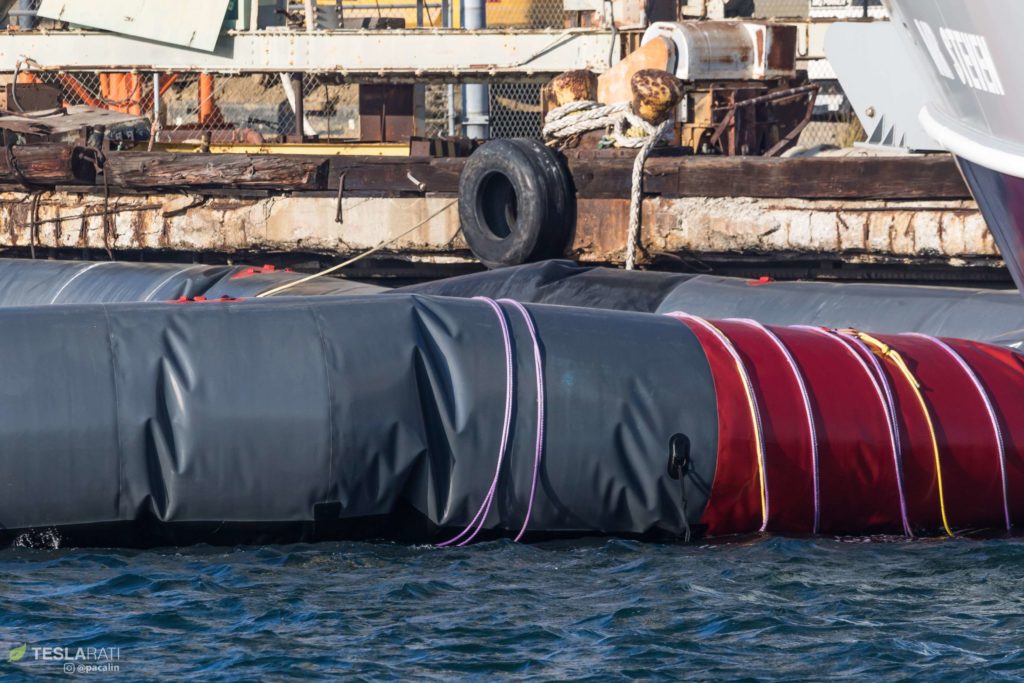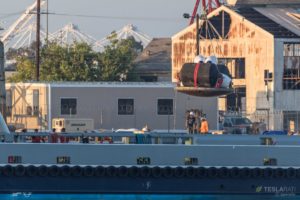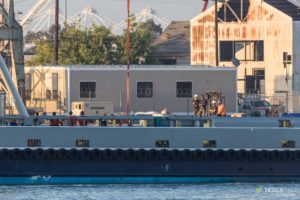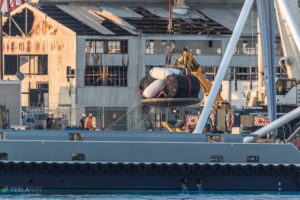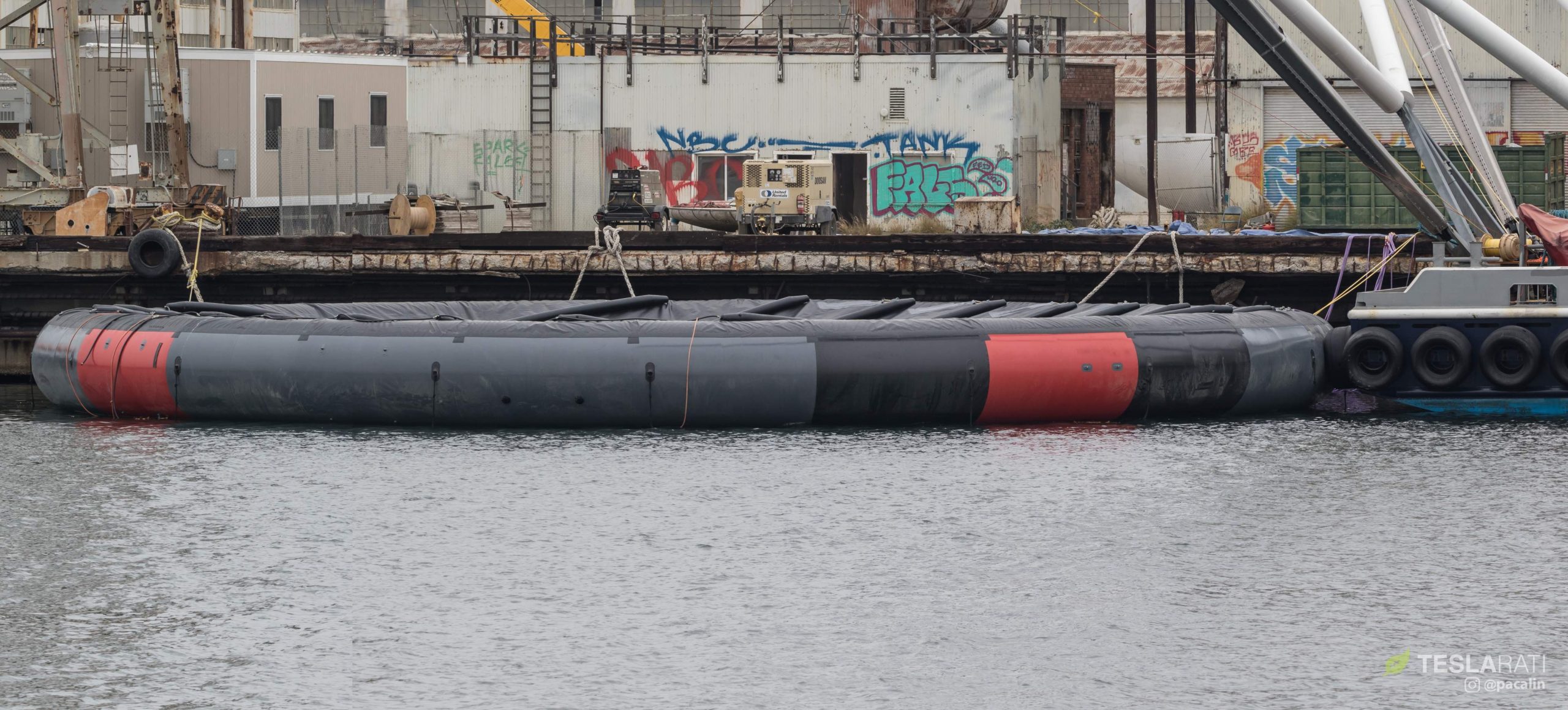
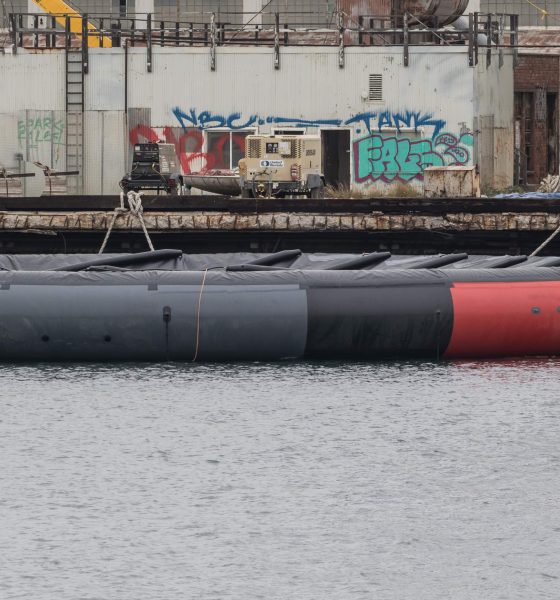
News
SpaceX gears up for Crew Dragon’s first recovery with a giant inflatable cushion
Paired with observations and comments from sources familiar with the company, all signs seem to indicate that SpaceX is planning to recover their first Crew Dragon spacecraft with a giant inflatable cushion, to be towed a hundred or so miles off the coast of California by one of the company’s Port of LA-stationed recovery vessels.
Despite a minor mishap during some sort of inaugural sea-trial of a custom Crew Dragon mass simulator, SpaceX technicians are pushing ahead with a test campaign intended properly characterize exactly how to best recover a Dragon while side-stepping around the problems caused by seawater immersion.
Inside the clean room at SpaceX HQ, Crew Dragon is nearing completion. This will be the capsule to make the first crewed flight, currently slated for April 2019.#spacex #CrewDragon @Teslarati pic.twitter.com/tjzuwfGV2O
— Pauline Acalin (@w00ki33) August 16, 2018
Why recover your Dragon?
First off, why would SpaceX choose to develop a new method of Dragon recovery – different than the company’s current experience with simply landing the capsules in the ocean – with the expectation that it will debut during the recovery of Crew Dragon after its very first demonstration mission (DM-1)? A huge number of unknowns and major questions remain, but the decision to attempt to avoid seawater immersion during the DM-1 Dragon recovery is very likely no coincidence.
Over the last several years, SpaceX engineers and technicians have learned a huge amount from recovering, refurbishing, and even reusing Cargo Dragons to resupply the International Space Station for NASA. Of all the lessons learned, the most unequivocal has to be a newfound appreciation for just how difficult it is to safely and reliably reuse spacecraft and rocket components after landing and being immersed in seawater. Despite SpaceX’s growing experience with reusing both Falcon 9 and Cargo Dragon, Dragons still typically require a bare minimum of 6-12 months of refurbishment before they are ready for another launch.
- SpaceX’s CRS-13 Cargo Dragon, capsule C108, seen near the end of its refurbishment. (SpaceX)
- A reused orbital spacecraft, Cargo Dragon, back on Earth after its second successful resupply mission. (SpaceX)
- All Crew and Cargo Dragons are built and refurbished in the same processing facility, a clean-room inside SpaceX’s Hawthorne, CA factory. (SpaceX)
For Crew Dragon’s DM-1 debut, it thus makes sense that SpaceX wants to recover the spacecraft in such a way that it is exceptionally easy to rapidly refurbish. Perhaps just several months after that capsule returns to Earth, currently expected no earlier than December 2018, SpaceX’s first crewed Crew Dragon demonstration’s tentative April 2019 launch debut will depend entirely on the completion and review of an In-Flight Abort (IFA) test planned just one month prior, March 2019.
The planned IFA test of Crew Dragon hinges entirely on DM-1 and Dragon refurbishment because the present plan (and launch schedule) absolutely depends on reflying DM-1’s Crew Dragon capsule, potentially recovered from orbit as few as three months prior.
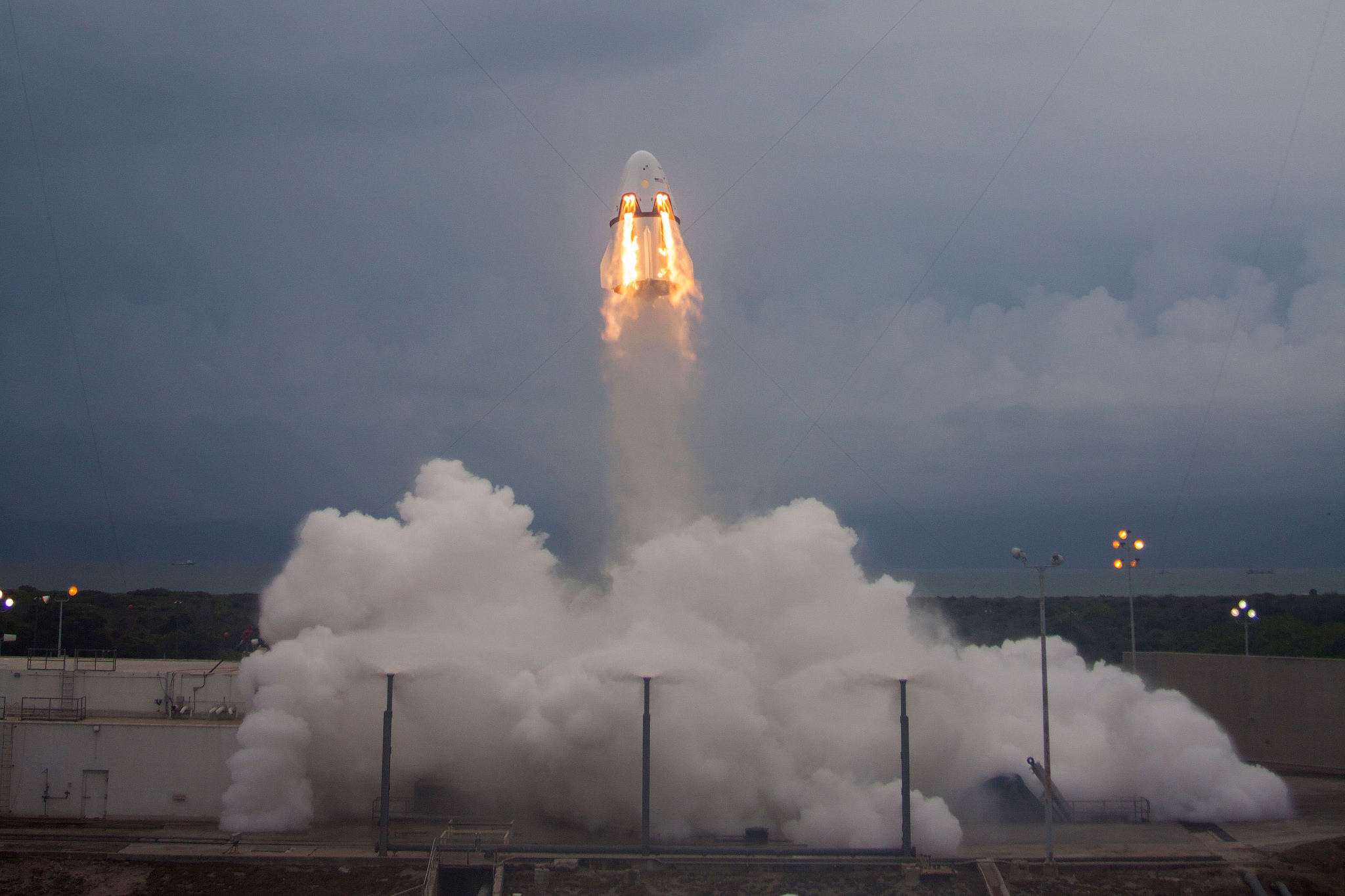
With a successful 2015 Pad Abort already under Crew Dragon’s belt, SpaceX voluntarily chose to conduct an additional complimentary in-flight abort not explicitly required by NASA, designed to demonstrate that Dragon will be able to safely extract astronauts from a failing rocket at the point of peak aerodynamic pressure (Max-Q). Essentially, a combination of successful aborts both on the launch pad and during Max-Q would theoretically demonstrate beyond any reasonable doubt that Crew Dragon really is capable of safely aborting a launch and protecting its astronauts at any point during launch.
Cargo Dragon has demonstrated that – apparently – no amount of heroics can refurbish the recovered spacecraft in just a small handful of months after seawater immersion, not without major changes to its design. As such, preventing that with some sort of inflatable cushion (or even Mr Steven’s net) would likely save many months of drying, cleaning, and requalification testing of all externally impacted components.
- Cargo Dragon returns to Earth looking rather well-done. (SpaceX)
- The first spaceworthy Crew Dragon capsule is already in Florida, preparing for its November 2018 launch debut. The same capsule will be refurbished and reflown as few as three months after recovery. (SpaceX)
- SpaceX Crew Dragon capsule C203 – then assigned DM-2 – is seen here in August 2018. (Pauline Acalin)
How to recover your Dragon
While the “why” is fairly obvious at this point, the “how” of actually making such a cushioned recovery happen is far less clear. Still, we at least know from several recent comments from SpaceX CEO Elon Musk and statements made in environmental impact analyses that the company has been considering such recoveries for some time.
Despite the fact that Crew Dragon’s original propulsive landing capability was nixed due to the unlikelihood of NASA ever certifying it for crewed landings and the expense required to attempt that certification, there is still clearly some latent interest (and value) in precisely landing Crew Dragon, even if only to speed up capsule and crew recovery after splashdown. A March 2018 preliminary environmental impact analysis of Gulf of Mexico Dragon recoveries – as a backup to bad weather in the Pacific and Atlantic – made the interest in precision exceptionally clear.
“The splashdown zone is a circle with a radius of approximately 5.4 nautical miles. … Dragon has been designed to perform precision landings in order to minimize the size of the splashdown zone and recovery time.”
Admittedly, a circle with a diameter of 10.8 nautical miles (20 km) does not exactly scream “precision” and ~20 km is likely around a thousand times less precise than what’s needed to land on the 30m-diameter inflatable structure present at Berth 240, but it’s probable that the splashdown zone as discussed is a worst-case scenario meant to give SpaceX’s recovery team plenty of wiggle room.
- Crew Dragon was originally designed with propulsive landings in mind, much like Falcon 9’s booster recovery. (SpaceX)
- In place of propulsive landing, it appears that a giant inflatable cushion is the new solution for quick reuse. (Pauline Acalin)
Musk also took a few seconds of a Falcon Heavy post-launch press conference to briefly describe Mr Steven, and he just so happened to touch on fairing and Dragon recovery:
“And we’ve got a special boat to catch the fairing. … It’s like a giant catcher’s mitt in boat form. I think we might be able to do the same thing with Dragon. So…if NASA wants us to, we can try to catch Dragon. Literally, it’s meant for the fairing, but it would work for Dragon, too.” – Elon Musk
Mr Steven takes one for the team
Even more experimental than fairing recovery, SpaceX happened to experience a minor incident while attempting to test aspects of its prototype Dragon catcher apparatus in early August. Partially captured by Teslarati photographer Pauline Acalin, SpaceX technicians were lifting a Crew Dragon heatshield mass simulator with a healthy topping of buoys onto Mr Steven. Moments after it was lowered onto the deck, the whole setup disappeared below the vessel’s side rails in a massive boom.
- The Crew Dragon mass simulator is loaded onto Mr Steven for the first time, August 3rd. (Pauline Acalin)
- Shortly after touchdown, the mass sim disappeared with a deafening boom, presumably breaking through Mr Steven’s wooden deck. (Pauline Acalin)
- SpaceX technicians lift a Crew Dragon mass simulator off of Mr Steven’s deck after accidentally breaking it. (Pauline Acalin)
According to sources familiar with SpaceX’s recovery fleet, the mishap was much less severe than the deafening noise it produced seemed to indicate from the sidelines. They described the aftermath as “an annoying accident” that was unlikely to take any significant amount of time to repair. More likely than not, Mr Steven’s wooden deck suffered some level of structural degradation after several years of active use, something that SpaceX technicians only discovered after loading (or maybe dropping) a heavy Dragon mass simulator aboard.
Regardless, one could certainly say that the test in question was more or less a success, as it most certainly demonstrated whether Mr Steven’s deck was actually capable of supporting the heavy test article (it was not). A few repairs and structural reinforcements later, the vessel is likely already back in working order, with photos taken on August 19th showing that the focus has returned to the vessel’s arms (two of which must have been removed earlier this week).

For prompt updates, on-the-ground perspectives, and unique glimpses of SpaceX’s rocket recovery fleet check out our brand new LaunchPad and LandingZone newsletters!

News
Tesla removes Safety Monitors, begins fully autonomous Robotaxi testing
This development, in terms of the Robotaxi program, is massive. Tesla has been working incredibly hard to expand its fleet of Robotaxi vehicles to accommodate the considerable demand it has experienced for the platform.

Tesla has started Robotaxi testing in Austin, Texas, without any vehicle occupants, the company’s CEO Elon Musk confirmed on Sunday. Two Tesla Model Y Robotaxi units were spotted in Austin traveling on public roads with nobody in the car.
The testing phase begins just a week after Musk confirmed that Tesla would be removing Safety Monitors from its vehicles “within the next three weeks.” Tesla has been working to initiate driverless rides by the end of the year since the Robotaxi fleet was launched back in June.
Two units were spotted, with the first being seen from the side and clearly showing no human beings inside the cabin of the Model Y Robotaxi:
A Tesla without a driver was spotted traveling on public roads! pic.twitter.com/ZLbduf4cKa
— TESLARATI (@Teslarati) December 14, 2025
Another unit, which is the same color but was confirmed as a different vehicle, was spotted just a few moments later:
NEWS: A second Tesla Model Y Robotaxi running FSD Unsupervised has just been spotted driving itself on public roads in Austin, Texas, with no one in the front seats.
This is a different car from the one spotted earlier. They have different license plates.
h/t @Mandablorian https://t.co/5URYsUGyD0 pic.twitter.com/CIUi4mXi33
— Sawyer Merritt (@SawyerMerritt) December 14, 2025
The two units are traveling in the general vicinity of the South Congress and Dawson neighborhoods of downtown Austin. These are located on the southside of the city.
This development, in terms of the Robotaxi program, is massive. Tesla has been working incredibly hard to expand its fleet of Robotaxi vehicles to accommodate the considerable demand it has experienced for the platform.
However, the main focus of the Robotaxi program since its launch in the Summer was to remove Safety Monitors and initiate completely driverless rides. This effort is close to becoming a reality, and the efforts of the company are coming to fruition.
Testing is underway with no occupants in the car
— Elon Musk (@elonmusk) December 14, 2025
It is a drastic step in the company’s trek for self-driving technology, as it plans to expand it to passenger vehicles in the coming years. Tesla owners have plenty of experience with the Full Self-Driving suite, which is not fully autonomous, but is consistently ranked among the best-performing platforms in the world.
News
Tesla refines Full Self-Driving, latest update impresses where it last came up short
We were able to go out and test it pretty extensively on Saturday, and the changes Tesla made from the previous version were incredibly impressive, especially considering it seemed to excel where it last came up short.
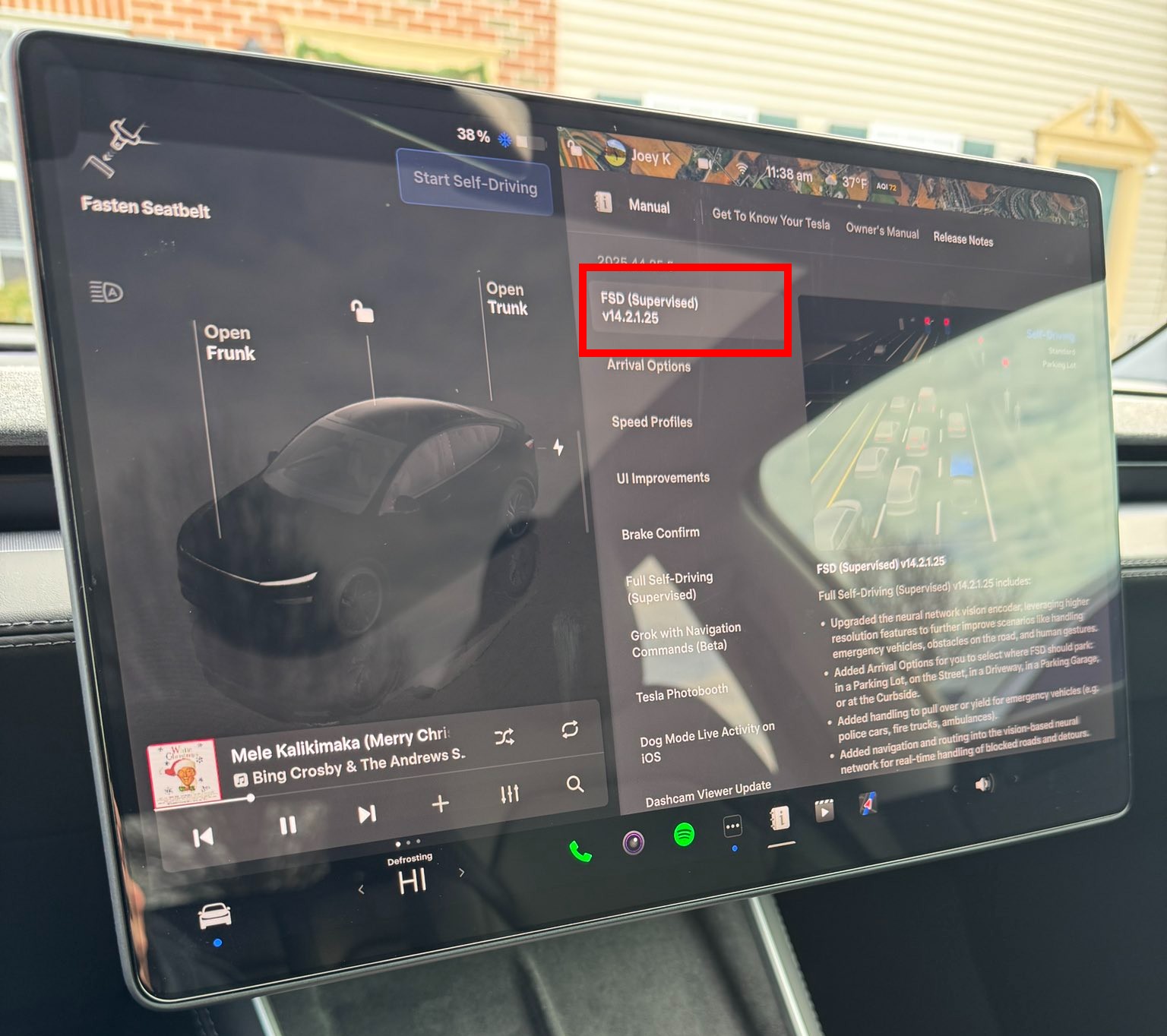
Tesla released Full Self-Driving v14.2.1.25 on Friday night to Early Access Program (EAP) members. It came as a surprise, as it was paired with the release of the Holiday Update.
We were able to go out and test it pretty extensively on Saturday, and the changes Tesla made from the previous version were incredibly impressive, especially considering it seemed to excel where it last came up short.
Tesla supplements Holiday Update by sneaking in new Full Self-Driving version
With Tesla Full Self-Driving v14.2.1, there were some serious regressions. Speed Profiles were overtinkered with, causing some modes to behave in a strange manner. Hurry Mode was the most evident, as it refused to go more than 10 MPH over the speed limit on freeways.
It would routinely hold up traffic at this speed, and flipping it into Mad Max mode was sort of over the top. Hurry is what I use most frequently, and it had become somewhat unusable with v14.2.1.
It seemed as if Speed Profiles should be more associated with both passing and lane-changing frequency. Capping speeds does not help as it can impede the flow of traffic. When FSD travels at the speed of other traffic, it is much more effective and less disruptive.
With v14.2.1.25, there were three noticeable changes that improved its performance significantly: Speed Profile refinements, lane change confidence, and Speed Limit recognition.
🚨 Many of you asked us to test highway driving with Tesla Full Self-Driving v14.2.1.25. Here’s what we noticed:
✅ Speed Profiles are significantly improved. Hurry Mode is no longer capped at 10 MPH over the speed limit, and now travels with the flow of traffic. This is much… pic.twitter.com/48ZCGbW0JO
— TESLARATI (@Teslarati) December 13, 2025
Speed Profile Refinement
Speed Profiles have been significantly improved. Hurry Mode is no longer capped at 10 MPH over the speed limit and now travels with the flow of traffic. This is much more comfortable during highway operation, and I was not required to intervene at any point.
With v14.2.1, I was sometimes assisting it with lane changes, and felt it was in the wrong place at the wrong time more frequently than ever before.
However, this was one of the best-performing FSD versions in recent memory, and I really did not have any complaints on the highway. Speed, maneuvering, lane switching, routing, and aggressiveness were all perfect.
Lane Changes
v14.2.1 had a tendency to be a little more timid when changing lanes, which was sort of frustrating at times. When the car decides to change lanes and turn on its signal, it needs to pull the trigger and change lanes.
It also changed lanes at extremely unnecessary times, which was a real frustration.
There were no issues today on v14.2.1.25; lane changes were super confident, executed at the correct time, and in the correct fashion. It made good decisions on when to get into the right lane when proceeding toward its exit.
It was one of the first times in a while that I did not feel as if I needed to nudge it to change lanes. I was very impressed.
Speed Limit Recognition
So, this is a complex issue. With v14.2.1, there were many times when it would see a Speed Limit sign that was not meant for the car (one catered for tractor trailers, for example) or even a route sign, and it would incorrectly adjust the speed. It did this on the highway several times, mistaking a Route 30 sign for a 30 MPH sign, then beginning to decelerate from 55 MPH to 30 MPH on the highway.
This required an intervention. I also had an issue leaving a drive-thru Christmas lights display, where the owners of the private property had a 15 MPH sign posted nearly every 200 yards for about a mile and a half.
The car identified it as a 55 MPH sign and sped up significantly. This caused an intervention, and I had to drive manually.
It seems like FSD v14.2.1.25 is now less reliant on the signage (maybe because it was incorrectly labeling it) and more reliant on map data or the behavior of nearby traffic.
A good example was on the highway today: despite the car reading that Route 30 sign and the Speed Limit sign on the center screen reading 30 MPH, the car did not decelerate. It continued at the same speed, but I’m not sure if that’s because of traffic or map data:
🚨 We listened to and read a lot of you who had a complaint of Tesla Full Self-Driving v14.2.1 incorrectly reading Speed Limit signs
This appears to be resolved in v14.2.1.25.
Here’s a breakdown: pic.twitter.com/TEP03xrMbt
— TESLARATI (@Teslarati) December 13, 2025
A Lone Complaint
Tesla has said future updates will include parking improvements, and I’m really anxious for them, because parking is not great. I’ve had some real issues with it over the past couple of months.
Today was no different:
🚨 My lone complaint with my drive on Tesla FSD v14.2.1.25 was this strange parking instance.
FSD swung out wide to the left to pull into this spot and this is where it seemed to be stumped. I gave it about 10 seconds after the car just stopped moving for it to make some… https://t.co/ZEkhTHOihG pic.twitter.com/TRemXu5DLf
— TESLARATI (@Teslarati) December 13, 2025
Full Self-Driving v14.2.1.25 is really a massive improvement over past versions, and it seems apparent that Tesla took its time with fixing the bugs, especially with highway operation on v14.2.1.
News
Tesla hints at Starlink integration with recent patent
“By employing polymer blends, some examples enable RF transmission from all the modules to satellites and other communication devices both inside and outside the vehicle.”

Tesla hinted at a potential Starlink internet terminal integration within its vehicles in a recent patent, which describes a vehicle roof assembly with integrated radio frequency (RF) transparency.
The patent, which is Pub. No U.S. 2025/0368267 describes a new vehicle roof that is made of RF-transparent polymer materials, allowing and “facilitating clear communication with external devices and satellites.”
Tesla believes that a new vehicle roof design, comprised of different materials than the standard metallic or glass elements used in cars today, would allow the company to integrate modern vehicular technologies, “particularly those requiring radio frequency transmission and reception.
Tesla has recently filed a US patent application on integrating RF transparent materials into the roof structure.
“facilitating clear communication with external devices and satellites”
Tesla fleet is getting @Starlink connectivity integration soon. LFG @Tesla @elonmusk… pic.twitter.com/bLa8YtPLd1
— Chansoo Byeon (@Chansoo) December 9, 2025
Instead of glass or metallic materials, Tesla says vehicles may benefit from high-strength polymer blends, such as Polycarbonate, Acrylonitrile Butadiene Styrene, or Acrylonitrile Styrene Acrylate.
These materials still provide ideal strength metrics for crashworthiness, stiffness for noise, vibration, and harshness control, and are compliant with head impact regulations.
They would also enable better performance with modern technologies, like internet terminals, which need an uninterrupted signal to satellites for maximum reception. Tesla writes in the patent:
“By employing polymer blends, some examples enable RF transmission from all the modules to satellites and other communication devices both inside and outside the vehicle.”

One of the challenges Tesla seems to be aware of with this type of roof design is the fact that it will still have to enable safety and keep that at the forefront of the design. As you can see in the illustration above, Tesla plans to use four layers to increase safety and rigidity, while also combating noise and vibration.
It notes in the patent that disclosed examples still meet the safety requirements outlined in the Federal Motor Vehicle Safety Standards (FMVSS).
Starlink integrated directly into Tesla vehicles would be a considerable advantage for owners. It would come with a handful of distinct advantages.
Initially, the inclusion of Starlink would completely eliminate cellular dead zones, something that is an issue, especially in rural areas. Starlink would provide connectivity in these remote regions and would ensure uninterrupted service during road trips and off-grid adventures.
It could also be a critical addition for Robotaxi, as it is crucial to have solid and reliable connectivity for remote monitoring and fleet management.
Starlink’s growing constellation, thanks to SpaceX’s routine and frequent launch schedule, will provide secure, stable, and reliable internet connectivity for Tesla vehicles.
Although many owners have already mounted Starlink Mini dishes under their glass roofs for a similar experience, it may be integrated directly into Teslas in the coming years, either as an upgrade or a standard feature.
